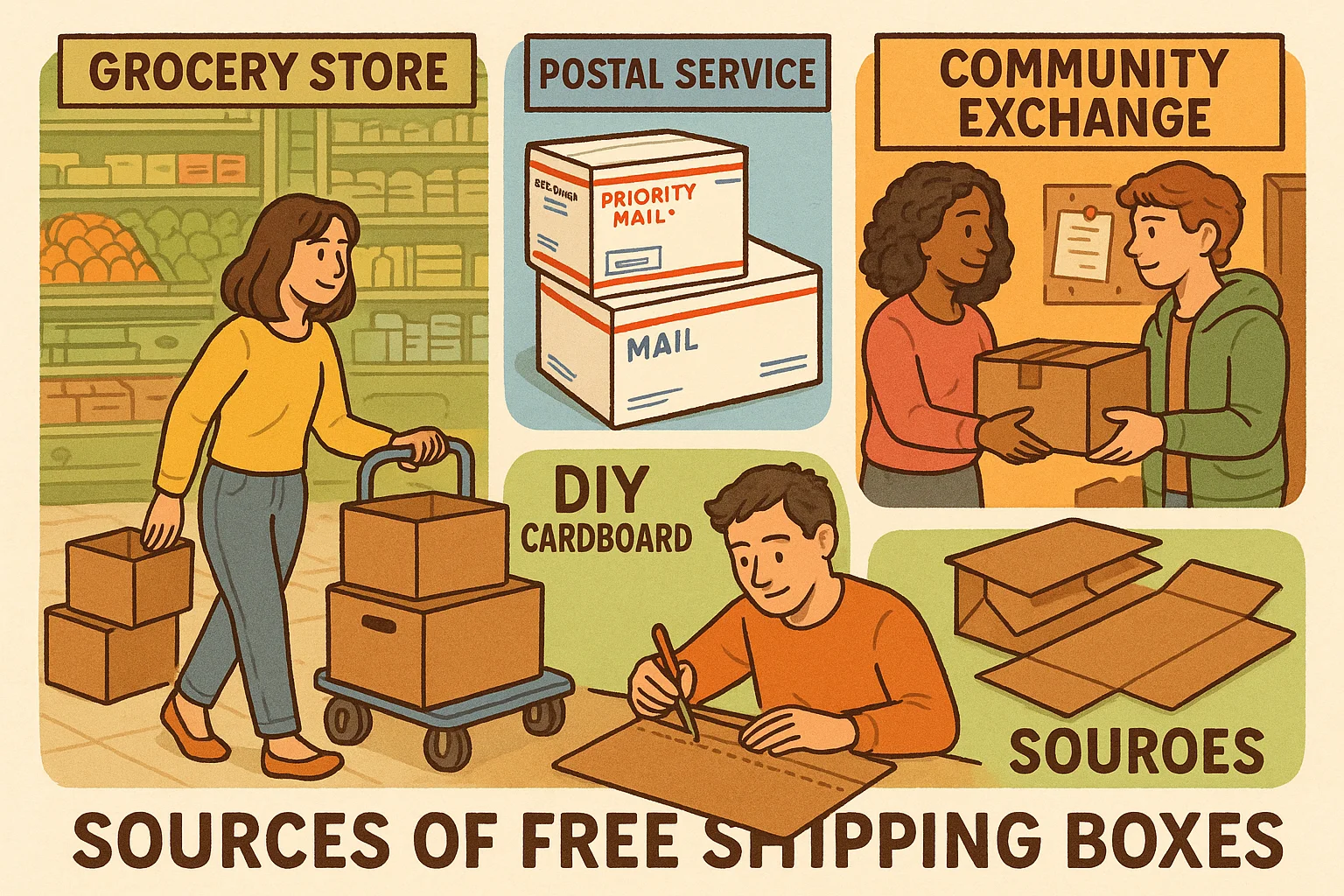Securing free shipping boxes can dramatically lower packaging costs for e-commerce sellers, small businesses, and individuals alike. Rather than purchasing new boxes, a variety of sources and strategies allow you to obtain sturdy, reliable containers at no cost. The following comprehensive guide will explore:
- Overview and main takeaway
- Retail and commercial sources
- Online platforms and community networks
- Institutional and municipal options
- Creative and DIY approaches
- Quality considerations and best practices
Main Takeaway: By tapping into a mix of local businesses, packaging carriers, community platforms, and creative reuse strategies, you can consistently source free shipping boxes in virtually any size and style-saving money, reducing waste, and ensuring your items ship safely.
1. Retail and Commercial Sources
1.1 Grocery and Big‐Box Stores
Most supermarkets and big‐box retailers receive frequent deliveries of canned goods, paper products, and household items in sturdy corrugated boxes. After staff unpack shipments, these boxes are typically discarded or flattened for recycling.
- When to Visit: Early mornings or late evenings, just after deliveries.
- Tip: Ask a manager or stocker if they have extra boxes they can set aside for donation.
1.2 Liquor Stores and Bottleshops
Alcohol shipments come in specially sized and reinforced boxes designed to prevent leakage and breakage. These are particularly useful for heavier or fragile items.
- Approach: Visit local liquor stores on days they receive deliveries (often weekdays) and inquire politely about spare containers.
1.3 Office Supply and Electronics Retailers
Electronics and office supplies (e.g., printers, paper reams, toner cartridges) arrive in robust double‐wall boxes. Stores such as Staples, Office Depot, and Best Buy often have the right‐sized boxes for flat items and small appliances.
- Best Practice: Offer to collect and remove flattened boxes to help keep the storeroom organized.
2. Shipping Carriers and Packaging Providers
2.1 USPS and Postal Outlets
The United States Postal Service provides free Priority Mail boxes, envelopes, and labels online or at local post offices. While these boxes must be used for postal shipments, they cover a wide range of sizes and ship flat to conserve space.
- Pick them up in person at any Post Office location.
How to Get Them:
Order online at store.usps.com and select “free shipping supplies.”
2.2 FedEx and UPS
FedEx Office locations and UPS Stores offer free branded boxes for Express and Ground services. These include envelopes, small, medium, and large boxes; some even fold out of flat stock.
- Usage Requirement: Shipments must utilize the corresponding carrier; however, you can repurpose surplus boxes for non‐carrier use if unbranded.
2.3 Regional and Local Carriers
Smaller regional carriers often have surplus or overstocked boxes they’re willing to give away. Establishing a friendly relationship can yield a steady supply.
- Suggestion: Contact customer service or local depot managers to inquire about donation programs.
3. Online Marketplaces and Community Networks
3.1 Freecycle, Craigslist, Facebook Marketplace
Community‐driven platforms boast robust “free” sections where individuals post moving boxes and packing materials. These platforms often feature near‐ideal, gently used boxes in bulk.
- Search Tips: Use keywords like “free moving boxes” or “free shipping boxes.”
- Timing: Listings peak at the beginning and end of each month, coinciding with common moving schedules.
3.2 Nextdoor and Local Neighborhood Apps
Neighborhood social networks facilitate quick asks and offers for free items. Posting a brief request-noting your intended use as “shipping supplies”-often elicits generous responses.
- Etiquette: Specify desired box sizes and offer to pick up promptly to streamline exchanges.
3.3 Business‐to‐Business Networks
Platforms like PackagingEco and local chamber of commerce bulletin boards connect businesses discarding packaging with startups or nonprofits in need.
- Benefit: Access commercial‐grade cardboard at no cost while reducing landfill contributions.
4. Institutional and Municipal Options
4.1 Libraries, Schools, and Nonprofit Organizations
Educational institutions and nonprofits frequently receive book and supply shipments in boxes that they may be willing to donate. Boxes for flat art supplies, books, and standardized formats are often available.
- Approach: Contact administrative offices or volunteer coordinators to arrange pickups.
4.2 Municipal Recycling Centers and Transfer Stations
Many recycling facilities have “reuse shelves” where residents can take or leave cardboard boxes in reusable condition.
- Note: Condition varies-inspect for structural integrity and water damage.
4.3 Corporate CSR and Donation Programs
Large retailers and manufacturers often partner with charities to redistribute packaging. Inquire with corporate social responsibility departments about donation schedules.
- Example: Amazon’s “Frustration‐Free Packaging” program sometimes distributes overstock boxes to community partners.
5. Creative and DIY Strategies
5.1 Repurposing E-Commerce Deliveries
If you shop online frequently, save incoming boxes from Amazon, eBay, and other vendors. These are often standardized, sturdy, and come in a variety of sizes.
- Organization: Keep a flattening station and store boxes by size for easy retrieval.
5.2 Dismantling and Resizing
Large boxes can be cut down to custom dimensions. By removing flaps and reassembling with packing tape, you can create small or medium boxes tailored to your items.
- Tool Kit: Utility knife, ruler, and heavy‐duty packing tape.
5.3 Salvaging Pallet Wrap and Strapping Materials
To maximize reuse, also collect bubble wrap, foam peanuts, and strapping bands from local suppliers. Combining these materials with free boxes ensures shipments remain protected.
5.4 Community Box Swaps and Pop-Up Exchanges
Organize periodic “box swap” events within coworking spaces, makerspaces, or community centers. Attendees bring surplus boxes and trade sizes as needed.
- Benefit: Reduces waste while fostering networking and community goodwill.
6. Quality Considerations and Best Practices
6.1 Inspect for Structural Integrity
- Flute Condition: Ensure corrugation layers are intact without significant crushing.
- Moisture Damage: Discard boxes with soft spots or water stains.
- Pest Inspection: Check for signs of insects or rodents, especially in boxes stored outdoors.
6.2 Standardize Box Sizes
Maintain a small inventory of commonly used sizes to reduce packing time and optimize shipping rates. Label flattened boxes with dimensions (length × width × height) for quick selection.
6.3 Cleanliness and Sanitization
Even new boxes can accumulate dust and debris. Wipe down surfaces or use compressed air to remove loose particles before packing fragile items.
6.4 Label Removal and Branding
If repurposing branded carrier boxes (e.g., “Priority Mail”), remove or cover original labels to prevent misrouting. Use plain white labels or blank tape to obscure logos.
6.5 Ethical and Environmental Responsibility
- Recycling Unusable Boxes: Donate damaged boxes back to local recycling programs.
- Supporting Local Businesses: Offer a small “thank you” to businesses providing boxes-this goodwill fosters long‐term supply relationships.
Conclusion
Obtaining free shipping boxes requires a blend of resourcefulness, networking, and sustainable practices. By leveraging retail and carrier sources, tapping into community networks, exploring institutional donation streams, and applying creative DIY methods, you can build a reliable repository of shipping containers at no cost. Prioritize quality checks and organizational systems to ensure these free resources meet your shipping needs reliably and responsibly. Whether you’re packing delicate crafts, heavy machinery parts, or everyday household goods, this guide equips you with the strategies to find-and maintain-an ongoing supply of free shipping boxes.



Leave a Reply